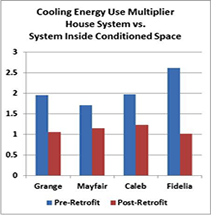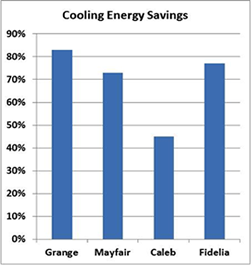The Whole House is a System
Houses are not a group of disassociated parts, but rather an interactive system with many subsystems.
Central Valley Research Homes Project: The Whole House Concept
Existing homes offer a huge and virtually untapped opportunity for energy efficiency upgrades. The CVRH Whole House Project is applying intensive scientific research to address these opportunities. The three year research project is underway in Stockton, CA. The project team is led by Bruce Wilcox, P.E. and includes Rick Chitwood and Proctor Engineering Group.
The project monitored four homes of different vintages (1948, 1953, 1996, and 2006) for the first year as a baseline. With these laboratories, the Project is testing optimized packages of upgrade measures for typical existing homes.
Huge HVAC Energy SavingsPutting the ducts in conditioned space has been the Holy Grail of ducted heating and cooling systems for some time. The CVRH project has proven that the ducts do not have to be in conditioned space to achieve high efficiencies. Three of these homes had the duct systems shortened, sealed, and super-insulated. By reducing the duct rest-rictions and reducing the size of the units, the cooling coil airflow was increased from an average of 297 CFM per ton to an average 534 CFM per ton. The existing systems then performed much better as shown in the figure to the right. |
|
 |
|
Reference HVAC Systems – the YardsticksEach of the houses has reference heating and cooling systems fully contained within the conditioned space (except the condensing units for the air conditioners). to operate on alternating time periods with the existing HVAC system. |
|
Huge Energy SavingsMyth: "You have to rebuild the house to save 50% or more of the cooling energy". NOT SO The three oldest homes saved an average of 77.7% of the cooling energy through simple, common retrofits (ducts, HVAC, insulation, air sealing, etc.). Only the newest home fell short with a 45% cooling energy savings. That home was already well insulated, with good windows. Prioritize by Check List
|
 |
||
|
The study involved baselineing, analysis, retrofitting, giving feedback to the occupants, and monitoring the effects on energy consumption. They discovered that the house did not act like the idealizations used in most engineering models.
When Gautam Dutt, one of the researchers, crawled into the attic he found that in the midst of the winter the attic was considerably warmer than the engineering model predicted it would be. Air leakage was detracting from the “on paper” effect of attic insulation (thermal bypasses).
Energy-Saving Solutions
- My utility bills are too high!
- Could my asthma be related?
- How do I know my AC is working efficiently?
- Does it really make any difference?
|
Morbi turpis augue, varius in vehicula vitae. Murus onare. Suspendisse potenti. Aliquam vel mi purus. Pacific Gas & Electric |
